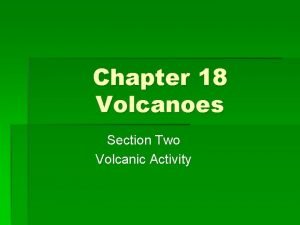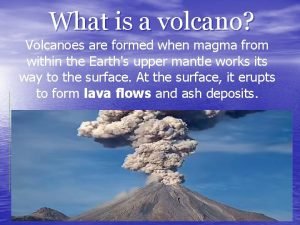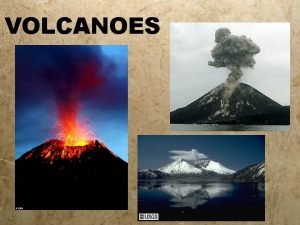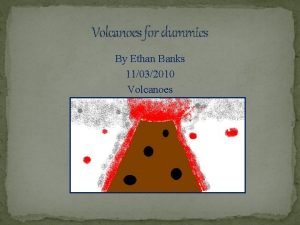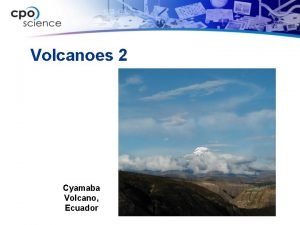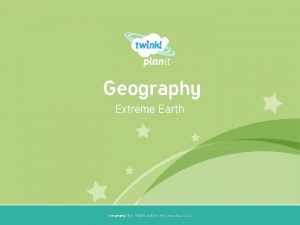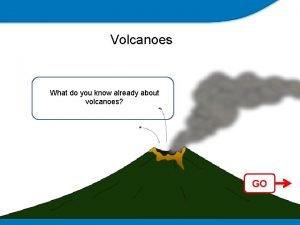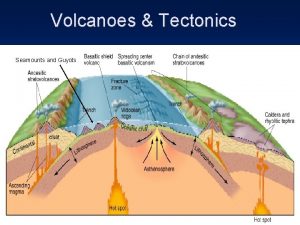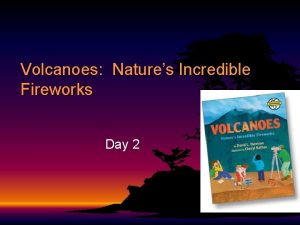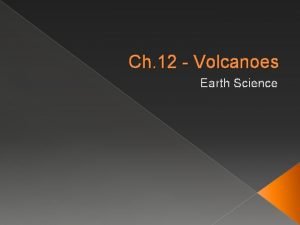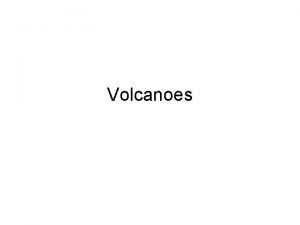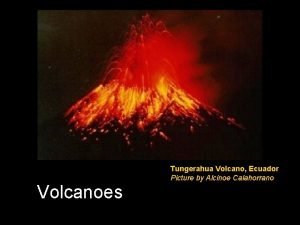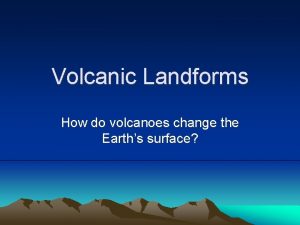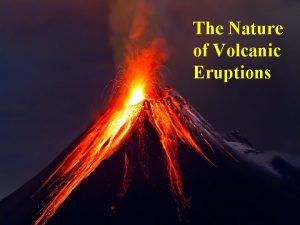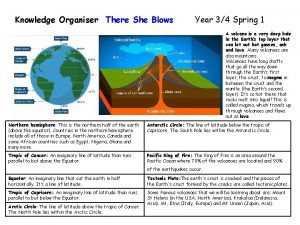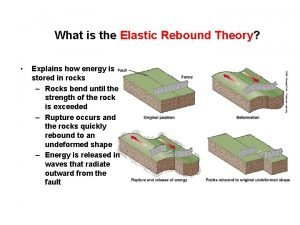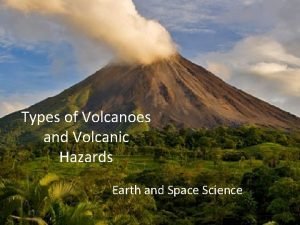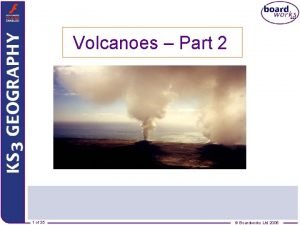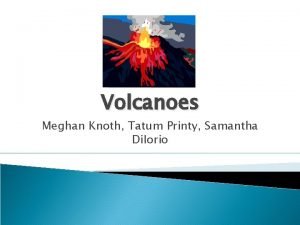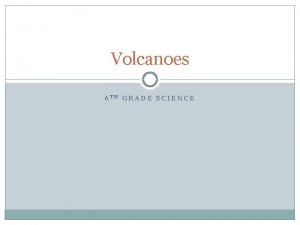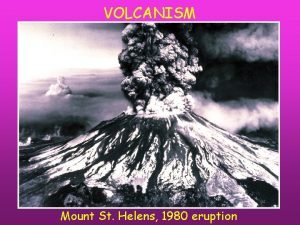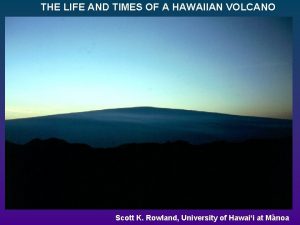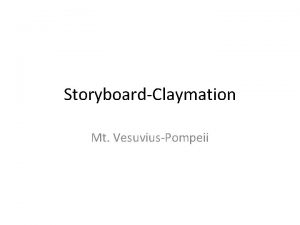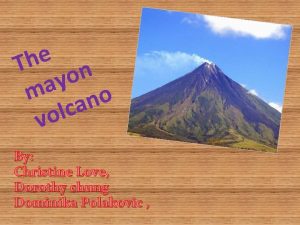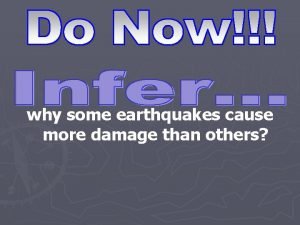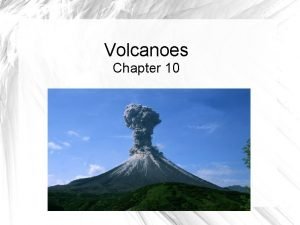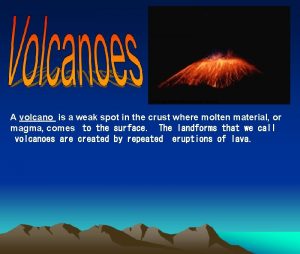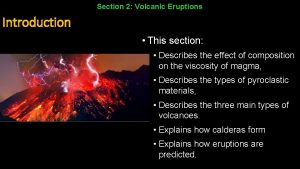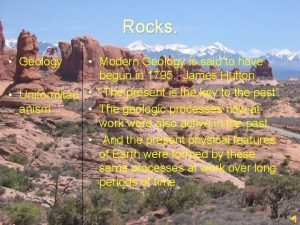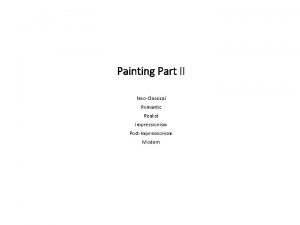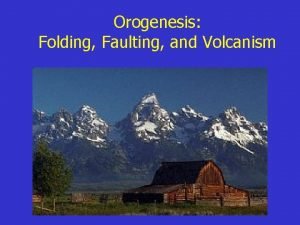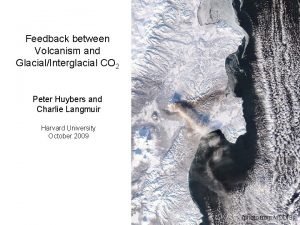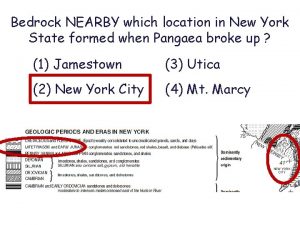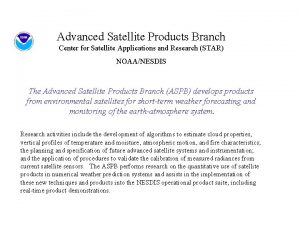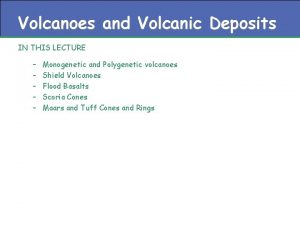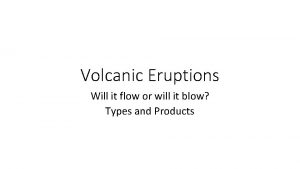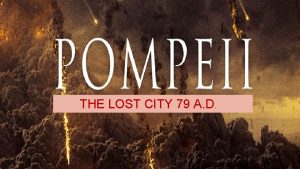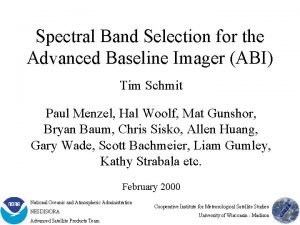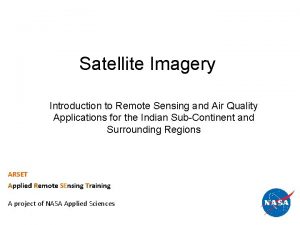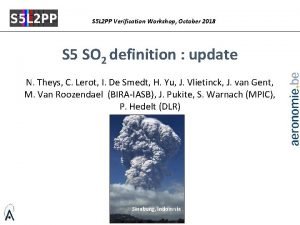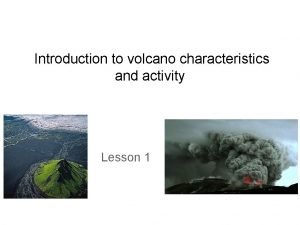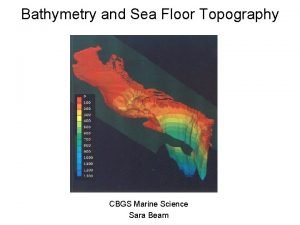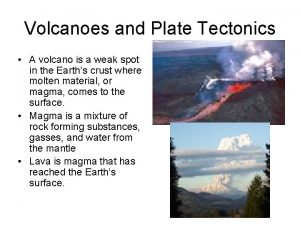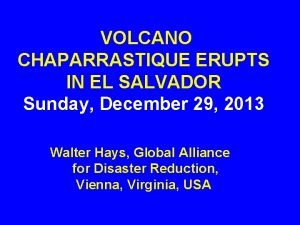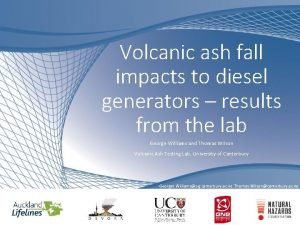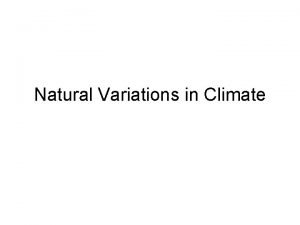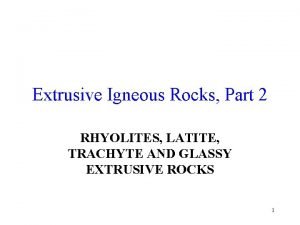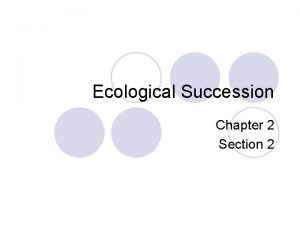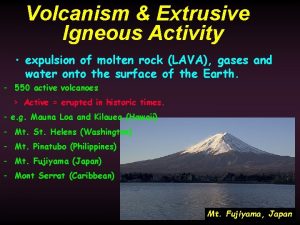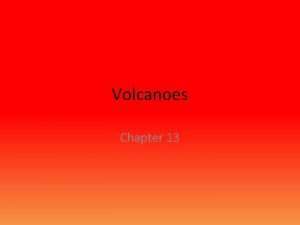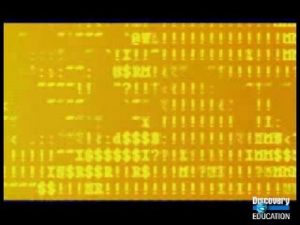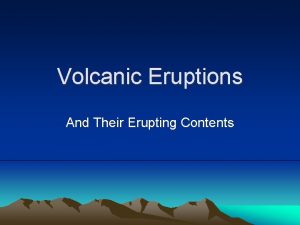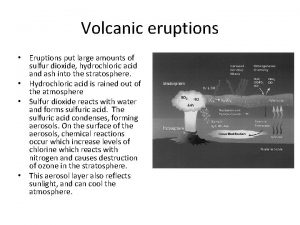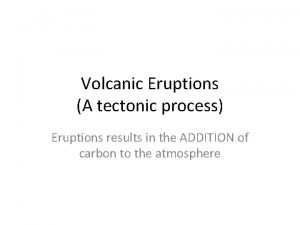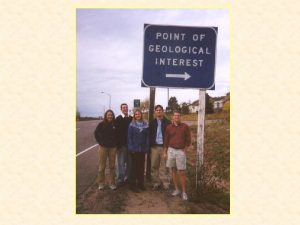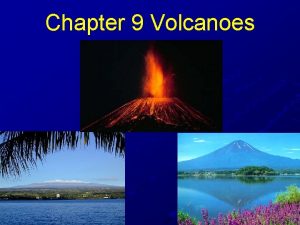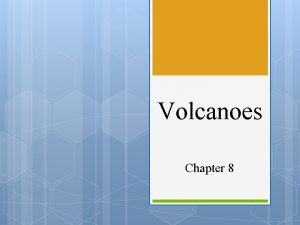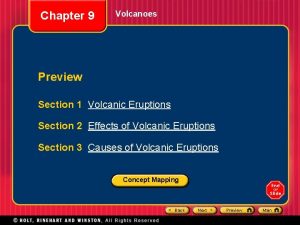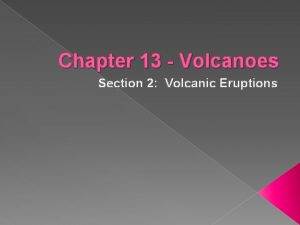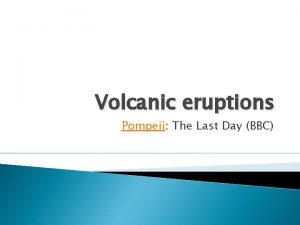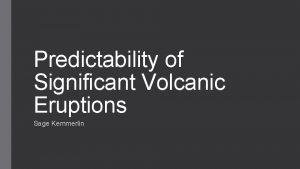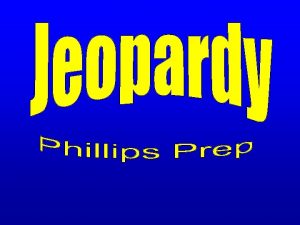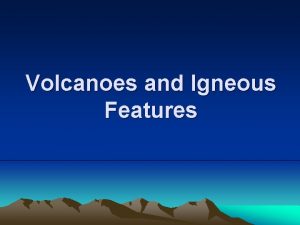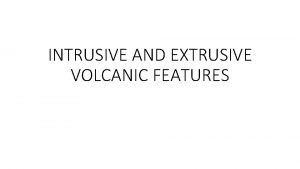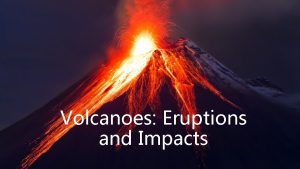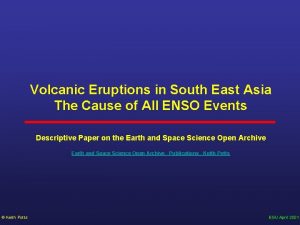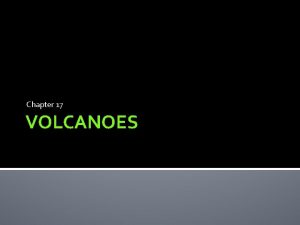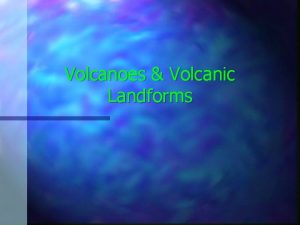Volcanoes Chapter 13 Volcanic eruptions cause some of





































































- Slides: 69

Volcanoes Chapter 13

Volcanic eruptions cause some of the most dramatic changes on the earth’s surface.


Some of them are more powerful than an atomic bomb.


Scientists can learn more about volcanoes by studying the relationship of temperature and pressure deep within the earth.


In most of the earth, the extremely high pressures at extreme depths keeps the rock solid. However, the smallest of fluctuations in pressure can cause the rock to melt and form magma (liquid rock under the earth’s surface).

When magma reaches the surface, it changes. It loses gases (sulfur dioxide and carbon dioxide) and water vapor and certain chemical reactions may occur with oxygen. Liquid rock above the earth’s surface is called lava.

Magma can form under three conditions: § An increase in temperature § A decrease in pressure § The addition of fluids which may affect melting point.


As magma forms, it melts surrounding rock and, since it is less dense than the surrounding rock, it travels upward along fissures. Any activity that includes the movement of magma on the surface of the earth is called volcanism.


Volcanism happens along major plate boundaries (both convergent and divergent). One of the most active volcanic zones is the Pacific Ring of Fire.

Major volcanic zones may occur along subduction zones.






When magma moves upward but does not reach the surface, the action is termed intrusive. The results of this activity are called plutons. They may be as large as batholiths and form the root for entire mountain ranges or as small as paper thin dikes.





Volcanic Eruptions Section Two

Volcanoes are formed by two general types of magma: • Free flowing mafic magma that is rich in iron and magnesium. It is dark in color and flows freely leading to quiet eruptions. Mafic magma is formed by the melting of the ocean plates. • Firm, light-colored felsic magma that is rich in silicates. It is light in color and does not flow but creates explosive plugs. It is formed by the melting of continental plates.

Eruptions may be: l l l Quiet – Eruptions occur Hawaiian style with lakes and rivers of free flowing lava. Explosive – Pyroclastics are blown over much of the countryside. Varied – The volcano goes through both explosive and quiet stages.

The largest amount of magma comes to the surface at the midocean ridges quietly as pillow lava. An exception is Iceland (the only midocean ridge which is above the surface of the ocean) where a rift zone tears the country in two.





Quiet eruptions of the ocean floor variety (mafic lava) also occur in Hawaii, a typical hot spot.




As felsic lavas erupt various pyroclastics are ejected: Ø Volcanic ash (less than 2 mm) is launched high into the atmosphere. Ø Particles less that. 25 mm are considered dust. Ø Pebble sized particles are called cinders or lapilli. Ø Bombs are ejected as liquid lava and solidify as they travel through the air. Ø Blocks are segments of rocks the size of a house that are launched into the air.





Sometimes pyroclastics are exploded, tumbled, and ground together, mixed with heavy gases such as sulfur and carbon dioxide and sent down the mountain side as a pyroclastic cloud.






Eruptions may produce deadly mudflows and flooding as the billions of tons of glaciers melt on top of the mountain.



Quiet mafic flows may produce: Pahoehoe or rope lava Aa or jagged chunks Block lava




The type of eruption affects the formation of the volcanic cone.

Quiet eruptions form gently sloping shield cones.

Varied eruptions form composite cones or stratovolcanoes.



Explosive eruptions form cinder cones.

The magma chamber may empty so fast that the cone collapses into the ground forming a cauldera.


Scientists constantly look for a pattern of events that may indicate a volcanic eruption. • Changes of temperature and pressure in rocks. • Small earthquakes • Surface bulges on the volcano • Emission of gases • Knowledge of prior eruptions • Animal behavior





 Chapter 8 earthquakes and volcanoes
Chapter 8 earthquakes and volcanoes Batholith
Batholith Chapter 18 volcanic activity
Chapter 18 volcanic activity Volcano diagram for kids
Volcano diagram for kids How are volcanoes classified?
How are volcanoes classified? Paboeboe
Paboeboe Ecuador
Ecuador Extreme earth
Extreme earth What do you already know about volcanoes?
What do you already know about volcanoes? Guyots
Guyots Volcanoes nature's incredible fireworks
Volcanoes nature's incredible fireworks Explain the theory of plate tectonics.
Explain the theory of plate tectonics. How are volcanoes formed
How are volcanoes formed Volcanic belts form along _____.
Volcanic belts form along _____. Active volcanoes map
Active volcanoes map Krakatoa volcano
Krakatoa volcano Paricutin materials extruded
Paricutin materials extruded Volcanoes knowledge organiser
Volcanoes knowledge organiser Rebound theory
Rebound theory Types of volcanoes
Types of volcanoes Ring of fire volcanoes
Ring of fire volcanoes Types of volcanoes according to shape
Types of volcanoes according to shape Lava and magma difference
Lava and magma difference Types of volcanoes
Types of volcanoes Name volcanoes
Name volcanoes Where are volcanoes
Where are volcanoes Volcanoes on oahu
Volcanoes on oahu Volcanoes of italy map
Volcanoes of italy map Differentiate active and inactive volcanoes
Differentiate active and inactive volcanoes Constructive and destructive forces
Constructive and destructive forces Ter death certificate
Ter death certificate Ultimate cause of behavior
Ultimate cause of behavior Proximate cause and ultimate cause
Proximate cause and ultimate cause Imprinting example
Imprinting example Why do some earthquakes cause more damage than others
Why do some earthquakes cause more damage than others They say sometimes you win some
They say sometimes you win some Sometimes you win some sometimes you lose some
Sometimes you win some sometimes you lose some Cream countable or uncountable
Cream countable or uncountable What are some contact forces and some noncontact forces
What are some contact forces and some noncontact forces Fire and ice diamante poem
Fire and ice diamante poem Some say the world will end in fire some say in ice
Some say the world will end in fire some say in ice Some trust in horses
Some trust in horses Factors affecting volcanic eruption
Factors affecting volcanic eruption Pinotubo
Pinotubo Thin layers of volcanic ash act as excellent time markers
Thin layers of volcanic ash act as excellent time markers Volcanic ash
Volcanic ash Volcanic ash
Volcanic ash Volcanic or plutonic rock
Volcanic or plutonic rock Volcanic ash
Volcanic ash Folding faulting and volcanic activity
Folding faulting and volcanic activity Volcanic features
Volcanic features Thin layers of volcanic ash act as excellent time markers
Thin layers of volcanic ash act as excellent time markers Volcanic ash
Volcanic ash Volcanic ash
Volcanic ash Volcanic ash
Volcanic ash Volcanic ash
Volcanic ash Volcanic ash
Volcanic ash Volcanic ash
Volcanic ash Volcanic ash
Volcanic ash Introduction of volcano
Introduction of volcano Volcanic island arc map
Volcanic island arc map Volcanic island arc
Volcanic island arc Volcanic belts form along the boundaries of earth's
Volcanic belts form along the boundaries of earth's Volcanic ash
Volcanic ash Population of argentina
Population of argentina Volcanic ash
Volcanic ash Igneous rocks
Igneous rocks Stages of secondary succession
Stages of secondary succession Volcanic cinder appraisal
Volcanic cinder appraisal Stratovolcano plate boundary
Stratovolcano plate boundary


